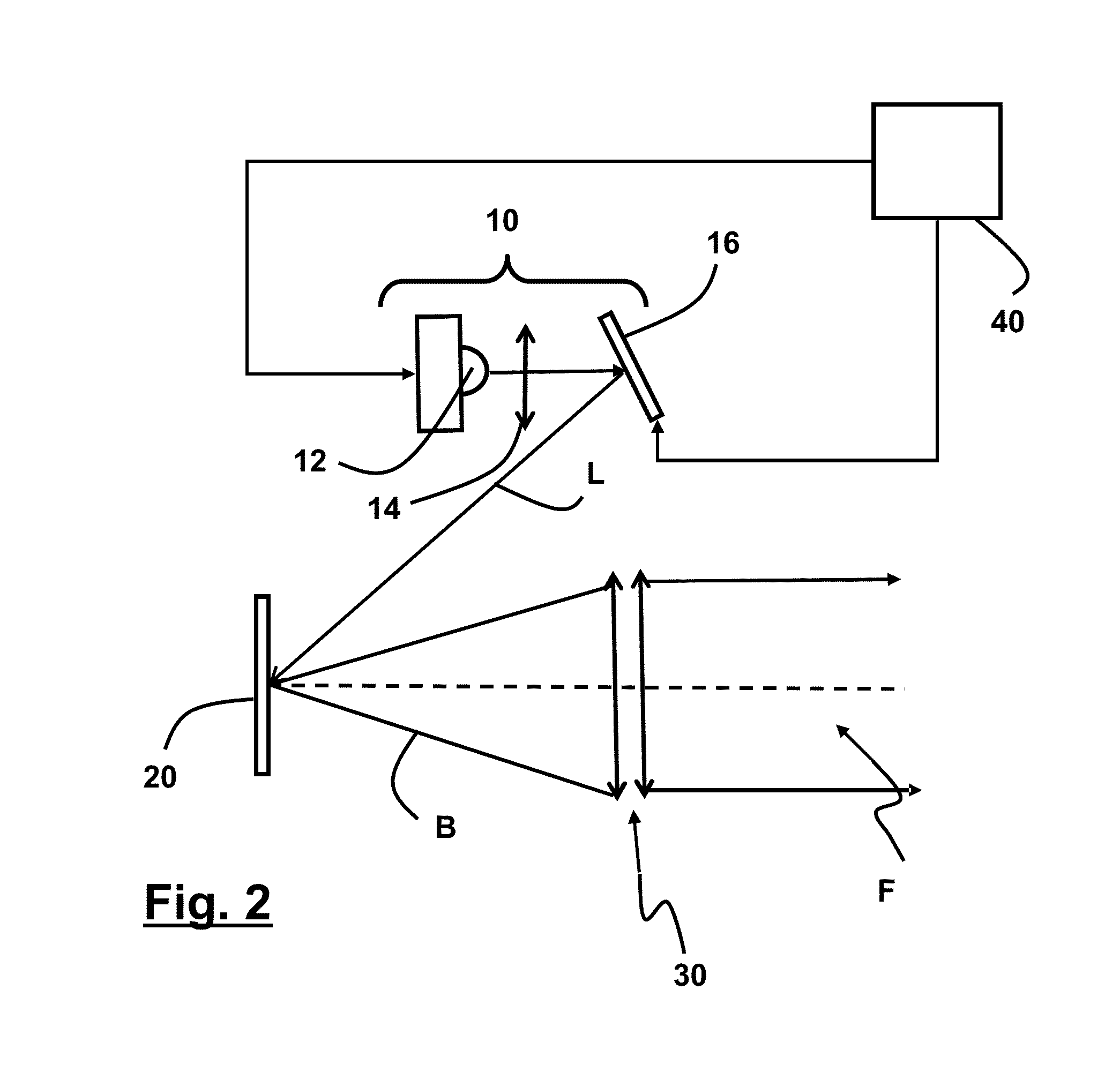Adaptive lighting system for an automobile vehicle
a technology for adapting lighting and automobiles, applied in fixed installations, lighting and heating devices, instruments, etc., can solve the problems of insufficient lighting of the road, dazzling other drivers, and only reducing the visibility of the front of the vehicle by the beam of ligh
- Summary
- Abstract
- Description
- Claims
- Application Information
AI Technical Summary
Benefits of technology
Problems solved by technology
Method used
Image
Examples
first embodiment
[0109] shown schematically in FIG. 5, the scanning is performed at constant speed, e.g. along the equidistant lines i, j, k, l, m and n.
[0110]Considering line i:
[0111]over a length D, the intensity of the laser radiation L is equal to a first value Imin, then,
[0112]over a length Di, the intensity of the laser radiation L is equal to a first value Imed, then,
[0113]over a length Di1, the intensity of the laser radiation L is equal to a second value Imax.
[0114]In addition, considering line n:
[0115]over a length D, the intensity of the laser radiation L is equal to a first value Imin, then,
[0116]over a length Dn, the intensity of the laser radiation L is equal to a first value Imed, then,
[0117]over a length Dn1, the intensity of the laser radiation L is equal to a second value Imax.
[0118]It is thus possible to obtain a predetermined light distribution in the pattern constituting the secondary source of radiation on the plate 20, by scanning the equidistant lines with variable intensitie...
second embodiment
[0119] shown schematically in FIG. 6, the scanning is performed at constant speed along non-equidistant lines.
[0120]In fact, it is known that a low beam such as that shown in FIG. 4 imposes a sharp cut-off. The cut-off of a low beam is a limit above which the light intensity must not exceed a value fixed by international regulations, so as not to dazzle other drivers traveling on the same road. The position in space of this cut-off is defined with high precision and the variation of the light intensity from one part to another of this cut-off is relatively abrupt.
[0121]In FIG. 4, the cut-off of the low beam F is materialized by a first horizontal segment C1, a second segment C2 inclined at 15° to the horizontal, and a third horizontal segment C3. The segments C1, C2 and C3 are images of the segments c1, c2 and c3 of the pattern created on the plate 20. It is seen therefore that the position of these segments c1, c2 and c3 on the plate 20 must be defined with great precision, also th...
third embodiment
[0125] shown schematically in FIG. 7, the scanning is performed at a variable speed. Only the scan line i is shown in this FIG. 7. Equal time intervals are shown as vertical dotted points. It is thus seen that the line i is divided into shorter and shorter intervals, each being covered in equal time, therefore at slower and slower speeds.
[0126]In FIG. 7, the shorter and shorter segments are shown as they approach the vertical Z′-Z axis. This signifies that the line i is scanned or covered more slowly near to the vertical axis than at the edges of the plate 20. If the laser beam has a constant light intensity, it results from this that the median zone of line i will be illuminated more intensely than the ends thereof, and therefore can re-emit a more intense white light.
[0127]By varying the scanning speed of the laser radiation of constant intensity, it is thus possible to modulate the intensity of the white light radiation re-emitted by different points of the secondary light source...
PUM
 Login to View More
Login to View More Abstract
Description
Claims
Application Information
 Login to View More
Login to View More - R&D
- Intellectual Property
- Life Sciences
- Materials
- Tech Scout
- Unparalleled Data Quality
- Higher Quality Content
- 60% Fewer Hallucinations
Browse by: Latest US Patents, China's latest patents, Technical Efficacy Thesaurus, Application Domain, Technology Topic, Popular Technical Reports.
© 2025 PatSnap. All rights reserved.Legal|Privacy policy|Modern Slavery Act Transparency Statement|Sitemap|About US| Contact US: help@patsnap.com



